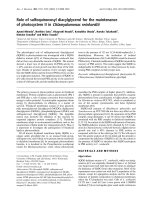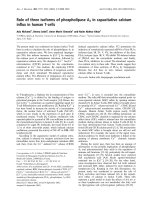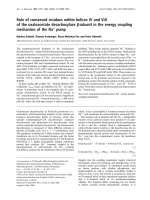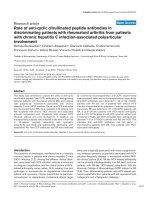Báo cáo y học: "Role of pathophysiology of patellofemoral instability in the treatment of spontaneous medial patellofemoral subluxation: a case report" docx
Bạn đang xem bản rút gọn của tài liệu. Xem và tải ngay bản đầy đủ của tài liệu tại đây (428.12 KB, 5 trang )
CASE REPO R T Open Access
Role of pathophysiology of patellofemoral
instability in the treatment of spontaneous
medial patellofemoral subluxation: a case report
Ertuğrul Akşahin
1*
, Feridun Yumrukçal
2
, Halil Yalçın Yüksel
1
,Dağhan Doğruyol
1
, Levent çelebi
1
Abstract
Introduction: Medial patellar subluxation is usually seen after lateral retinacular release. Spontaneous medial
subluxation of the patella is a very rare condition. There are few reports in the literature on the pathophysiology of
iatrogenic medial patellar subluxation. To our knowledge, there are no reports of the pathophysiology of non-
iatrogenic medial patellar subluxation in the English literature . In this study we present a case of spontaneous
medial patellar instability that is more prominent in extension during weight bearing. We also try to define the
treatment protocol based on pathophsiology.
Case presentation: We report the case of a 21-year-old Turkish man with spontaneous medial patellar instability.
He had suffered right knee pain, clicking and popping sensation in the affected knee for three months prior to
presentation. Clinical examination demonstrated medial patellar subluxation that is more prominent in extension
during the weight bearing phase of gait and while standing. Increased medial tilt was observed when the patella
was stressed medially. Conventional anterior to posterior, lateral and Merchant radiographs did not reveal any
abnormalities. After three months of physical therapy, our patient was still suffering from right knee pain which
disturbed his gait pattern. Throughout the surgery, medial patellar translation was tested following the imbrication
of later al structures. He still had a medial patellar translation that was more than 50% of his patellar width.
Patellotibial ligament augmentation using an iliotibial band flap was added. When examined after surgery, the
alignment of the patella was effectively corrected.
Conclusions: Chronic imbalance between the strengths of vastus lateralis and vastus medialis results in secondary
changes in passive ligamentous structures and causes additional instability. Physical therapy modalities that aim to
strengthen the vastus lateralis might be sufficient for the treatment of spontaneous medial instability. There would
be no need for any surgical intervention if spontaneous medial instability was recognized before the additional
instability occured. If necessary, lateral imbrication followed by lateral patellotibial ligament augmentation can be
performed, and these would effectively correct spontaneous medial patellofemoral instability.
Introduction
Medial patellar subluxation is a disabling clinical entity
that is usually seen after surgical procedures performed
for lateral patellofemoral instability. These procedures are
lateral retinacular release [1-6] and medial transfer of tibial
tubercle [7]. Medial patellar subluxation without any pre-
vious surgical procedure is extremely rare. We detected
163 reported cases of medial patellar subluxation in the
English literature. Eight cases were of post-traumatic
patients and only five were spontaneous, while the remain-
ing cases were secondary to previous surgical procedure
[1,4,8].
Although few surgical methods such as direct retina-
cular repair [1,4], reconstruction of patellotibial ligament
using iliotibial band, patellar tendon or fascia lata [4,9]
and a rthroscopic medial retinacular release [8] are sug-
gested methods for the treatment of medial patellar
instability, etiology was not taken into consideration
in any of these studies. The choice of surgical method
for different pathophysiologies, therefore, has yet to be
defined.
* Correspondence:
1
Ankara Numune Education and Research Hospital, Ankara, Turkey
Akşahin et al. Journal of Medical Case Reports 2010, 4:148
/>JOURNAL OF MEDICAL
CASE REPORTS
© 2010 Akşahin et al; licensee BioMed Central Ltd. This is an Open Access article distributed under the terms of the Creative Commons
Attribution License ( which permits unrestricted use, distribution, and reproduction in
any mediu m, provided the original work is properly cited.
Here we present a case of spontaneous medial patellar
subluxation that is more prominent in extension while
weight bearing.
Case presentation
A 21-year-old T urkish man was admitted to our clinic
for right knee pain, clicking and popping sensation in
the affected knee for three months prior to his presenta-
tion. Difficulties in climbing stairs and disability during
sports activities were the other symptoms of our patient.
He reported no previous physical or surgical treatment
for any other knee pathology and did not have any
known history of trauma. On our patient’ sphysical
examination, atrophy of the quadriceps muscle was
observed. Medial patellar apprehension test was positive
and increased passive medial patellar mobility was
observed when his patella was stressed medially. His
gravity subluxation test was negative. His physical exam-
ination also revealed that medial subluxation of his right
patella was more prominent in extension while weight
bearing (Figures 1 and 2). We also noted patellofemoral
hypermobility. He had no complaints related with his
left knee. Conventional anterior to posterior, lateral and
Merchant radiographs of our patient did not reveal any
abnormality.
Our patient was initially treated wi th physical therapy.
A quadriceps s trengthening rehabilitation program and
neuromuscular stimulation focused on the vastus latera-
lis muscle and was continued for three months. After
three months of rehabilitation, some improvement w as
achieved in his quadriceps strength and the medial
translation of his patella was less than the pre-treatment
level. However, he still suffered from right knee pain,
which disturbed his gait pattern. As such, surgery was
planned.
Using a lateral parapatellar approach, we first per-
formed direct lateral retinacular imbrication. We evalu-
ated provocative patellofemoraltrackingduringflexion
andextensionofthekneebypressingontheinferior
lateral pole of his patella. The achieved patellar stability
was not sufficient and his patella was still moving medi-
ally more than 50% of its width. We dissected a strip of
his iliotibial band approximately 1 cm wide and 4 cm i n
length, thus leaving distal base of the strip attached to
Gerdy’ s tubercle. Using this strip, we augmented the
patellatibial ligament. As the medial subluxation of h is
patella was more prominent in extension, we tensioned
the strip in extension.
Post-operatively our patient’s knee was immobilized
using a brace for six weeks. He was allowed to walk
with partial weight bearing after the first post-operative
day until the fourth post-operative week. During the
first week he was allowed to perform passive knee
extension and active assistive flexion exercises within a
range o f 0 to 90°. F ull active r ange of motion exercises
and full weight bearing was allowed after the third post-
oper ative week. Quadriceps strengthening ph ysical ther-
apy focused on the vastus lateralis with neuromuscular
stimulator was continued for three months after the
operation. A home exercise program was also given to
our patient.
He was examined weekly for the first month. Follow-
up visits were made by phone interview monthly
and by clinical examination at intervals of three
months. By the end of the sixth week of the surgery
he achieved full range of motion. Meanwhile, full
Figure 1 The patellofemoral relationship of our patient at supine position.
Akşahin et al. Journal of Medical Case Reports 2010, 4:148
/>Page 2 of 5
quadriceps strength was achieved at the end of the
third post-operative month. Our patient did not
experience any patellofemoral instability during his
follow up examinations.
During his last visit for follow-up examination, atro-
phy of his quadriceps muscle was completely resolved
and both medial patellar apprehension and passive med-
ial patellar mobility tests of our patient were negative.
Gravity subluxation test was also negative. He was eval-
uated subsequently according to the clinical score and
pain scale defined by Hu ghston et al. [4] (Table 1). O ur
patient’s pre-operative functional level limited perfor-
mance of his daily activities. At the end of the first year,
however, he was categorized as vigorous recreational.
Whileheusedtohaveseverepain,hedescribedmild
pain with competitive sports in the post-operative
period and no pain with daily activities.
Discussion
Debate s on the diagnosis and treatment of medial patel-
lar subluxation have been ongoing since it was first
described by Hughston and Deese [3] in patients who
have undergone lateral retinacular release. Iatrogenic
medial patellar subluxation following lateral retinacular
release is a rare entity and non-iatrogenic medial patel-
lar dislocation, whether traumatic or spontaneous, is
even more uncommon. Among the 163 cases of medial
patellar s ubluxation reported in the literature [8], only
five were spontaneous [1,4,8].
However, in the study conducted by S hellock et al .
[10], patellofemoral tracking had been evaluated
by kinematic magnetic resonance imaging (MRI) in
130 patients with symptomatic patellofemoral joint. The
authors discovered that there was medial patellar sub-
luxation in 106 of the patients (41%). Thus they con-
cluded that the non-iatrogenic medial patellofemoral
subluxation is a far more common clinical entity, but
has not been appreciated in patients with knee pain.
On the other hand, the studies on the pathophysiology
of iatrogenic medial subluxatio n of the patella revealed
that detachment of vastus lateralis fr om the patella is
the most encountered reason [3,11]. Nonweiler and De
Lee [11] analyzed five patients with positive gravity sub-
luxation test, which indicates that vastus lateralis is not
Figure 2 Medial subluxation of the right patella was more prominent while bearing weight.
Table 1 Functional level and intensity of pain reported
by patients undergoing surgical correction of medial
subluxation of the patella (data from Hughston [5]).
Functional level Pain
External support required or sedentary activities None
Activities of daily living Mild
Light recreational Moderate
Moderate recreational Severe
Vigorous recreational Totally disabling
Competitive
Highly competitive
Akşahin et al. Journal of Medical Case Reports 2010, 4:148
/>Page 3 of 5
functioning properly. They concluded that the main
reason f or medial patellar s ubluxation following lateral
release was vastus lateralis insufficiency. In contrast to
this common opinion about the etiopathology of medial
instability of patients who underwent lateral release,
Quervain et al. [12] claimed that medial patellofemoral
instability is mostly caused by the insufficiency of the
lateral retinaculum following the release of the
patellotibial and the epicondylopatellar ligaments. The
authors evaluated two pat ients suffering from medial
subluxatio n who had undergone lateral release with gait
analysis, and they suggested that subluxation was
becoming more prominent in the unloading phase of
gait when the quadriceps was inactive.
We found nothing in the literature that describes
the pathophysiology of spontaneous medial patellar
instability. Although there is no s atisfactory information,
the treatment algorithm is almost the same with iatro-
genic and traumatic group. In o ur case we observed that
medial subluxation was more prominent during the
weight bearing phase of gait when our patient’squadri-
ceps were active. Additionally, during surgery, we did not
observe any problem with vastus lateralis integrity. In our
opinion, rather than the imbalance between medial and
lateral passive structures of the knee joint, long-term
overdominancy o f vastus medialis to vastus lateralis was
probably playing a major role in the pathophysiology of
medial subluxation as in our the case of our patient.
Because the pathophysiology of iatrogenic and sponta-
neous medial patellar subluxation varies, rehabilitation
program should also vary. Physical therapy focused on
the quadriceps muscle strengthens both the vastus later-
alis and medialis muscles. Although the imbalance
between these two muscles maybelesseneditwould
not be eliminated. For this reason we additionally
applied electrical stimulus to vastus lateralis muscle for
three months pre-operatively. At the end of the third
month, although our patient had already achieved some
improvement in his quadriceps strength and medial
translation of p atella he was still suffering from right
knee pain which disturbed his gait pattern. We thought
that the reason for medial subluxation was not only the
vastus medialis overdominancy, but also the insuffi-
ciency of lateral passive structures due to irreversible
elongation of the ligaments as a result of this chronic
imbalance of the active structures. Furthermore, we
speculate that the misdiagnosed patients with occult
medial patellar instability described by Shellock et al.
[10] are probably the precursors of advanced stage med-
ial patella subluxation and dislocations. As available
physical therapy measures were not sufficient to restore
the balance between the ligamentous structures, we
planned surgery to reconstruct these structures.
Different methods have been published for the surgi-
cal treatment of medial instability [1,4,7-9,11]. Hughston
et al. [4] published a report on surgically treated 65
knees with medial instabil ity. They have performed
direct repair of the lateral retinaculum in 39 patients,
and the remaining 26 were treated with the reconstruc-
tion of patellotibial ligament, of which 12 were by t he
help of iliotibial band and 14 were by the help of patel-
lar tendon. They concluded that the reconstruction of
lateral patellotibial l igament effec tively corrected medial
instability. Recently, Shannon and Keenel [8] r eported
satisfactory results of arthroscopic medial retinacular
release for me dial instability of patella. Two of the cases
they described were spontaneous. They emphasized that
arthroscopic medial patellar release was a suitable
method of treating spontaneous medial patellar instabil -
ity but also noted that this method should not be used
in hypermobile patella. In another study conducted by
Richman and Scheller [1], a patient with spontaneous
medial instability was successfully treated with imbrica-
tion of the lateral retinaculum.
In our case m edial translation of patella was more
than 50% when medial patellar laxity test was per-
formed, t hus indicating a hypermobile patella. We thus
preferred t o utilize an o pen surgical technique. Follow-
ing the imbrication of lateral structures, medial patellar
translation was tested and it was still more than 50%.
As a result, we decided to augment the insufficient
lateral structures of our patient. We performed
patellotibial ligament augmentation using an iliotibial
band flap described by Hughston et al. [4] and success-
fully restored our patient’s patellofemoral stability. At
the end of the treatment period he co uld already return
to his daily activities.
Conclusions
Spontaneous medial patellar instability is a subtle clini-
cal entity caused by an imbalance between the strength
of vastus lateralis and vastus medialis. Physical therapy
modalities aiming to strengthen the vastus lateralis
might be enough for the treatment of spontaneous
medial instability without necessitating any surgical
intervention. This would only be possible, however, if
spontaneous medial instability is diagnosed before
additional instability occurs in the lateral patellar reti-
nacular structures due to chronic overlengthening. If
surgery is indicated due to these secondary changes in
the passive structures, lateral imbrication followed by
an additional lateral patellotibial ligament augmenta-
tion if necessary, can be performed. These would effec-
tively correct spontaneous medial patellofemoral
subluxation. Data from larger case series are needed to
define the pathophysiology of medial patellofemoral
Akşahin et al. Journal of Medical Case Reports 2010, 4:148
/>Page 4 of 5
instability and the different etiologies and also to treat
patients appropriately.
Consent
Written informed consent was obtained from our
patient for publication of this case report and any
accompanying images. A copy of the written consent is
available for review by t he Editor-in-Chief of this
journal.
Author details
1
Ankara Numune Education and Research Hospital, Ankara, Turkey.
2
Department of Orthopedics and Traumatology, Erzincan State Hospital,
Erzurum, Turkey.
Authors’ contributions
EA and FY analyzed and interpreted our patient’s data, performed the
surgery and contributed in writing the manuscript. HYY and LC drafted the
manuscript and revised it critically for important intellectual content. DD
participated in the medical interventions, took the photographs, and
undertook the literature review. All authors read and approved the final
manuscript.
Competing interests
The authors declare that they have no competing interests.
Received: 21 September 2009 Accepted: 22 May 2010
Published: 22 May 2010
References
1. Richman NM, Scheller AD: Medial subluxation of the patella without
previous lateral retinacular release. Orthopedics 1998, 21(7):810-813.
2. Kolowich PA, Paulos LE, Rosenberg TD, Farnsworth S: Lateral release of the
patella: indications and contraindications. Am J Sports Med 1990,
18(4):359-365.
3. Hughston JC, Deese M: Medial subluxation of the patella as a
complication of lateral retinacular release. Am J Sports Med 1998,
16(4):383-388.
4. Hughston JC, Flandry F, Brinker MR, Terry GC, Mills JC III: Surgical
correction of medial subluxation of the patella. Am J Sports Med 1996,
24(4):486-491.
5. Henry JH, Goletz TH, Williamson B: Lateral retinacular release in
patellofemoral subluxation. Indications, results and comparison to open
patellofemoral reconstruction. Am J Sports Med 1986, 14(2):121-129.
6. Miller PR, Klein RM, Teitge RA: Medial dislocation of the patella. Skeletal
Radiol 1991, 20(6):429-431.
7. Abhaykumar S, Craig DM: Fascia lata sling reconstruction for recurrent
medial dislocation of patella. Knee 2003, 10:215-220.
8. Shannon BD, Keene JS: Results of arthroscopic medial retinacular release
for treatment of medial subluxation of the patella. Am J Sports Med 2007,
35(7):1180-1187.
9. Brinker MR, O’Connor DP, Flandry F, Hughston J: Diagnosis and surgical
correction of medial patellar subluxation. Oper Tech Sports Med 2001,
9:183-189.
10. Shellock FG, Mink JH, Deutsch AL, Fox JM: Patellar tracking abnormalities:
clinical experience with kinematic MR imaging in 130 patients. Radiology
1989, 172(3):799-804.
11. Nonweiler DE, DeLee JC: The diagnosis and treatment of medial
subluxation of the patella after lateral retinacular release. Am J Sports
Med 1994, 22(5):680-686.
12. Kramers-de Quervain IA, Biedert R, Stüssi E: Quantitative gait analysis in
patients with medial patellar instability following lateral retinacular
release. Knee Surg Sports Traumatol Arthrosc 1997, 5(2):95-101.
doi:10.1186/1752-1947-4-148
Cite this article as: Akşahin et al.: Role of pathophysiology of
patellofemoral instability in the treatment of spontaneous medial
patellofemoral subluxation: a case report. Journal of Medical Case Reports
2010 4:148.
Submit your next manuscript to BioMed Central
and take full advantage of:
• Convenient online submission
• Thorough peer review
• No space constraints or color figure charges
• Immediate publication on acceptance
• Inclusion in PubMed, CAS, Scopus and Google Scholar
• Research which is freely available for redistribution
Submit your manuscript at
www.biomedcentral.com/submit
Akşahin et al. Journal of Medical Case Reports 2010, 4:148
/>Page 5 of 5









